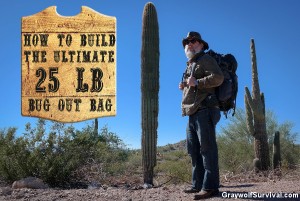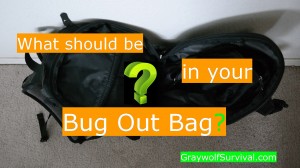
Basic planning for preppers: P.A.C.E.
Preppers plan. At least, they should. But do you know how to plan properly? Being a prepper means you prepare but proper planning involves more than just buying prepper gear or learning survival skills. Those are immensely important but if you don’t have a plan, you have to make things up as you go.
Being adaptable is important but if you want to give yourself and your family the best chance of surviving a SHTF or disaster situation, you have to plan ahead. One of the reasons the Special Forces is so good at what they do is because they plan, and plan, and plan. Then then run through what they’ve planned, adjust their plan, and run through it again. They do it so many times that they not only don’t have to think about what they’re doing when it comes time to execute, when things go wrong, they have a plan to fall back to so they know what everyone else is doing even without communicating it. It’s all about planning and practicing.
But most people don’t really have military training on how to plan. There’s a whole crapload of information the military has on how to plan. If you really want to get into it, get a hold of a copy of FM 5-0, The Operations Process.
If you’ve ever read an Army field manual, you know they’re hella thorough but damn. I wanted to break things down into manageable chunks for people new to prepping. Even though this article’s written for beginning preppers, the concept is usually missed by even by some of the most advanced preppers. Once you’ve read it, I’d be interested to hear in the comments how you’ve used PACE in the past for military operations or prepping.
Like many other plans you make for security, communications, SHTF or just general operations, you need to have backup plans because things go wrong. It’s all well and good to make a plan of what you’re gonna do when you hit the AO but the realities change once you hit the ground. For the purposes of this lesson, I’ll just expand a bit on the Family Emergency Communications Plan I wrote about previously so you have something you can relate to and actually use.
You did read that post, didn’t you? {sigh}. Go ahead, read it. We’ll wait…
Ok. You should really keep up.
As I was saying. We’re gonna use the communications plan as an example for this post. Let’s say that in part of your plan, you’re gonna try to plan to get a hold of your cousin Biff. Biff’s a great guy, but he’s a little stupid. Because of this, we’re gonna make a fairly thorough plan. We’ll assume you’ve already gone over with Biff about when this plan would be executed and when it wouldn’t but he needs to know exactly what he needs to do if SHTF as far as how you’re gonna communicate. Most people would just come up with one plan – the primary plan – and call it good. You’re a prepper though, and a damn good one, so you’re gonna make a thorough plan. You’re gonna use PACE for your communications plan with ol’ Biff.
What is PACE?
PACE stands for:
Primary
Alternate
Contingency
Emergency
Primary
This is the overall best plan of action to take or system to use based on the most likely and most damaging scenario you’re planning on dealing with. It’s your Plan A. This is where most people end. It’s typically a good plan but if you haven’t gone through different scenarios of what could go wrong, how do you know?
Let’s just put one down for shit’s and giggles. Our Primary plan if SHTF is for you two to try to contact each other using your cell phone. You notice that I didn’t specify that you should call Biff. You need to try to be a bit flexible in your planning. What happens if Biff notices that there’s an emergency situation that calls for the communications plan to be activated but you haven’t? Should he be sitting there waiting like an idiot? No, he should be doing something. This something should be very specific, as flexible as possible, and be very likely to work.
Primary plan to make contact with Biff in case SHTF:
If XYZ happens, and I haven’t been contacted by Biff, I will call him on his cell phone at 867-5309 using my cell phone. This number will be programmed in my phone and be written on a note in my den and in my emergency contact list that’s in my bugout bag. If Biff notices that XYZ has happened and hasn’t heard from me, he’ll contact my cell phone at 555-1212, which will be programmed into his cell phone and a copy put in the centerfold page of his favorite 1972 Playboy that’s sitting in his garage.
See what we’ve done here so far? The primary plan is specific, but it has flexibility built into it. Either of us could initiate the call and we both have at least two ways to get the number. The plan doesn’t specify that a certain phone be used, just that a certain phone is called.
It’s a good plan, and honestly a more thorough plan than most people would use, but it has holes in it. What if Biff got so excited the day you needed to reach him that left his phone at the purchasing counter of the National Yack Convention so you can’t call him? You need another plan.
Alternate
In theory, your Alternate plan (Plan B) should be just as viable as your Primary plan. That isn’t always gonna be the case but you should reach for that. Why do we have alternate plans? Because things happen.
How you decide what your alternate plan is gonna be is situation-dependant. Let’s talk generalities.
You don’t want to just come up with a secondary method of doing what you’re trying to do. Look at what some of the most likely problems that could cause your primary plan to not work and then come up with a plan that fits with your situation that won’t be affected by those problems. Whenever possible, come up with several holes in your primary plan and find an alternate that’s just as good but covers all those bases.
So for our example, just to make it simple, we’ll just assume that the most likely problem would be Biff not having his damn phone again. So in this case, we need an alternate plan that doesn’t require his cell phone.
Since Biff doesn’t really exist, I can make stuff up to make a point. Let’s assume he’s a HUGE Farmville addict so he’s always playing throughout the day. An alternate plan could be that if SHTF, you’ll pop open a chat window on facebook and give him enough information that he knows what to do without blowing your OPSEC.
Think that’s not a realistic scenario? There were several occasions in Afghanistan where we couldn’t get a hold of one of our teams by cell phone but noticed one of them logged into facebook so we just told them to grab an available phone and call in. Cell coverage was spotty, as was the internet, but it worked.
So we have a one-way solution to the alternate plan. You should never stop there if you can because you lose flexibility. To make the plan work both ways, we’ll assume you have a smart phone and computer around at all times. If you adjust things to match the plan, you could just ensure you were always logged in somewhere and had your notifications set up to let you know if someone contacted you through facebook.
So, the alternate plan to make contact with Biff in case SHTF:
If XYZ happens and you can’t reach Biff by his cellphone, you’ll find the nearest computer or smart phone, log into facebook and send a message to Biff. If he’s online, this would open a chat window. If not, this would leave a message. Biff just needs to know that he has to pay attention when he’s playing Farmville to notice a chat window pop up or a message notification. If Biff realizes he needs to make contact with you and he can’t reach you by cell for whatever reason, he’ll send you a facebook message too.
In all these cases, you should come up with a few scenarios so you know what you can say quickly to get your point across without anyone else knowing. Facebook isn’t exactly secure.
Contingency
Your contingency plan is what you’re gonna do if you can’t do the first two for whatever reason. The contingency isn’t always (or isn’t usually) as good a choice as the others but you need a backup. It should be something that doesn’t rely on what the others do.
For example, let’s say that you primary plan was to call Biff on his cell and you chose to call his wife Betty on her cell if that didn’t work. It wouldn’t be prudent to then choose calling his neighbor’s cell as a contingency plan because you’ve just created a SPOF (Single Point Of Failure). What happens if the reason you can’t reach Biff is because the cell system went down, like it can do in big emergencies? You won’t be able to call Betty, causing you to have to initiate your contingency plan. Guess what’s gonna happen if you try to call the neighbor.
For our contingency plan, let’s not rely on cell phones or the internet. Since we know Biff works every day at the widget plant, and he knows you work as a masseuse at Billy’s Place, your contingency plan could be to drive to the others’ office and find each other or leave a note. See a problem with this plan as it sits? What happens if you both notice there’s been an emergency and the cell phones don’t work so you both head out for each others’ workplace. Might want to build that into your plan.
So, the contingency plan to make contact with Biff in case SHTF:
If XYZ happens and I can’t get a hold of Biff by cell or get on facebook, I’ll either head to Biff’s office or mine first (whichever’s closer) and if Biff isn’t there, I’ll leave a note and then head to the other workplace. Biff will do the same thing.
Emergency
This is the plan you go for if all else fails but you probably don’t want to use it. You may be lucky enough to find an emergency plan that’s a really good plan but the biggest key about the emergency plan is that it should be your most flexible plan that has the best chance of succeeding, no matter what the circumstances.
An emergency plan may not be the most convenient plan, or the one that is best for OPSEC, but it should be as foolproof as possible. Let’s assume you’ve both gotten your ham radio licenses, because any serious prepper’s gonna do that. You could for example, prearrange a time and frequency schedule that you both agree to occasionally check.
So, the emergency plan to make contact with Biff in case SHTF:
If XYZ happens and I can’t reach Biff by cell, facebook or at our office, I will broadcast on my ham radio per the time and frequency schedule as often as possible until I reach him and he’ll do the same.
The whole plan
If XYZ happens:
- Primary:
- If I haven’t been contacted by Biff, I will call him on his cell phone at 867-5309 using my cell phone. This number will be programmed in my phone and be written on a note in my den and in my emergency contact list that’s in my bugout bag.
- If Biff notices that XYZ has happened and hasn’t heard from me, he’ll contact my cell phone at 555-1212, which will be programmed into his cell phone and a copy put in the centerfold page of his favorite 1972 Playboy that’s sitting in his garage.
- Alternate:
- If I can’t reach Biff by his cellphone, I’ll find the nearest computer or smart phone, log into facebook and send a message to Biff. If he’s online, this would open a chat window. If not, this would leave a message to make contact and how I’m available to be reached.
- Biff will begin to pay attention when he’s playing Farmville to notice a chat window pop up or a message notification. If Bill realizes he needs to make contact with me and he can’t reach me by cell for whatever reason, he’ll send me a facebook message letting me know how to make contact.
- Contingency:
- If I can’t get a hold of Biff by cell or get on facebook, I’ll either head to Biff’s office or mine first (whichever’s closer) and if Biff isn’t there, I’ll leave a note and then head to the other workplace.
- Biff will do the same thing.
- Emergency:
- If I can’t reach Biff by cell, facebook or at our offices, I will broadcast on my ham radio per the time and frequency schedule as often as possible until I reach him.
- If Biff can’t reach me by cell, facebook or at our offices, he’ll broadcast on his ham radio per the time and frequency schedule as often as possible until he reaches me.
So for your plan, whether it be a part of a commo plan, part of a bugout route, or part of your tactical home defense plan, you’ll want to break down each part of your PACE sections, avoid any common points of failure, and then put the whole thing together into an overall plan. Then you need to make sure everyone involved understands the plan, and starts doing what they need to to make the plan work (such as setting up your notifications). Then practice like there’s an emergency while you throw in curveballs such as the cell towers not working.
Doing all this may seem like overkill, and in a lot of cases it is, but if it could mean the difference between protecting your family or not, don’t you think you should put some time and effort into it?








great post, I as many others lack in this realm. I just get to over whelmed. I am one of those people who can get stuck in a “what if” mode. there are just so many possibilities that I dont know how to plan for them. I do have a sadly laid out plan. but dont know what to really go with on back up plans. and then practice runs of all different possibilities till they are second nature? wow! I totally agree with what you say just hard to implement them. in a good way and a very sad way I dont have to coordinate with others outside my house because None of them are awake! they think I am paranoid.
some of my planning issues are, WHEN do you bug out? how do you know its time to make that call?
My Next issue is I want to make it to a area I know has all sorts of supplies naturally. what if they roads are closed or cars dont work? the area I have picked out has lots of wildlife, plant life, fish and even an artisan well. Not many know of the well. then there is “what if” others have made it to my ideal location all ready? I dont have a clue what to do then. if they are nice people we’d be fine but if they are hostile I dont think we’d be able to handle that.
right now we are going to bug in till we can get a clear idea as to whats going on then we will bug out if necessary. I have also instructed friends even the sleeping ones that if SHTF that we will be bugged in for as long as we can be then we will be leaving and if communication is down and they come to our place we will have detailed instructions Hidden in a spot they know to look. thats as advanced as we have been able to get at the moment.
The when is difficult to preplan. In general, you should stay home until you either have to leave or your opportunity to leave is about to close. Always try to stay put if you can. I’m kind of equating a SHTF scenario with what I’ve seen in Africa.
Bugging out is inherently dangerous. Not only are you more than likely leaving your resupply (unless you’ve cached properly), you’re introducing a lot of unknown variables that you’ll have to deal with. Always stay if you can. I’ll be writing some posts on bugging out vs bugging in and how to make those plans in the future but they’re pretty big topics considering the amount of unknowns.
If you haven’t yet, read my post that discusses route assessments. It discusses how to plan your route. There’s a lot more to discuss about that but it’ll give you something to start with.
Dealing with others along the way or at your bugout location is a huge thing to deal with and very difficult to plan ahead for. The best you can do is learn about people and how to build rapport. If they have a group, you’re not going to be able to bully your way through but you may be able to get them to help you.
The communication thing is a big thing. It’s one of the most important things. I’ve been caught before separated from elements of my team when all comms went down. Luckily we had already coordinated what we would do in what circumstances. That way we knew what to do and knew what each other was doing. You have to wargame possible scenarios and then come up with what is the smartest course of action for each. That’s where this PACE stuff comes in because you need to think ahead what you’re gonna do without knowing what your circumstances are gonna be.